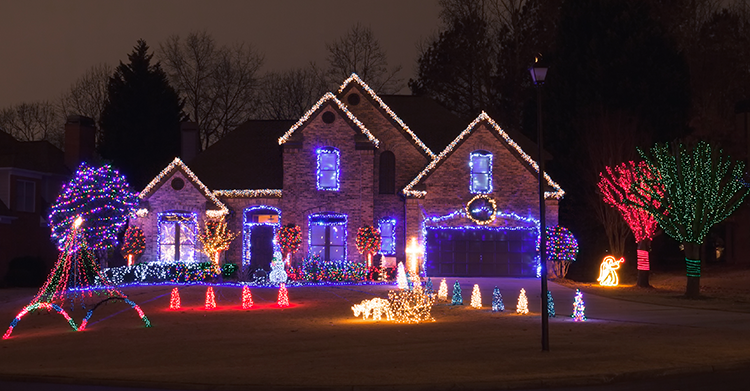
When decorating your home for the holidays, you don’t want to compromise safety or design. There's always that house on the street that goes all out for Christmas and blows everyone else's light display out of the water. And then there's the house with a single sad string of lights that looks like it was thrown up in a matter of minutes with little to no thought. You don’t want to be the sad house. However, don’t sacrifice your safety for it. Falling off the ladder, getting a bad shock, or starting a house fire is not how you want to celebrate. It’s not worth risking your life and safety just to add a little glam to your home for a few short weeks.
How to Safely Hang Christmas Lights
Know Your Limits
Climb up onto a ladder only if you’re confident in your abilities and you have the proper equipment. If not, have someone else do it for you, such as a friend, family member, or a professional light installer. Otherwise, you can just stick to hanging lights around the house from the ground. You can create lovely effects by simply stringing lights on trees, bushes, windows, mailboxes, and pathways. Try to get your lights up before the weather gets nasty so the process is both safer and more comfortable for you.
Use a GFCI-protected Outdoor Outlet with a Cover
A ground fault circuit interrupter (also used in many kitchens and bathrooms) is designed to cut off the power to the outlet automatically if it comes into contact with moisture. An outlet cover will help keep moisture out in the first place.
Use an Outdoor Extension Cord
Make sure your extension cord is designed specifically for outdoor use and has been rated for safety by an independent testing agency; it should have a UL mark of approval. Also be sure the cord you select can handle the maximum amperage of the lights to which they will be supplying electricity. If your cord can’t handle the electrical current required for your lights to work, the cord could overheat, and you could end up with a power outage or a fire.
Pick Out the Right Lights
When it comes to Christmas lights, you can choose from white, yellow, colored, icicle, net lights, bulbs, and many other varieties. Pick out the kinds and colors of lights you love. Just make sure they are labeled for outdoor use. Think about buying LEDs rather than incandescent lights. They may cost a little more up front, but they will consume much less energy and are designed to last longer. They’re also safer because they don’t overheat. Never use a strand of lights if any part of it is frayed or damaged, and don’t stray from the manufacturer’s guidelines for any of the products you use. Follow the instructions for safety, maintenance, and use.
Design Tips for Hanging Christmas Lights
Come Up with a Design
Before you jump in and start putting lights up around the house, take a step back and come up with a plan. You might even want to grab a sketchpad to take with you to the front of your house. This way, you can draw an outline and map out where you want to place what. Do you want a straight row of lights along your gutters? Icicle lights? Net lights for bushes? Consider adding a focal point, a centralized area where you can get a little fancier with your lights.
Measure
After you decide where you want to place all the lights, grab a tape measure and measure all the straight lines (e.g. roofline, railings, doors, window frames). Remember to take into account the distance to the power outlet so your strands don't fall short.
Purchase the Proper Clips
You can find light clips for just about any type of surface: gutters, shingles, rooflines, decks, etc. Take a trip to the store and read the packaging labels to find the best clips for your application. Hanging lights improperly can damage your home, which can void your warranties.
Test Your Lights Before You Hang Them
If you just dug a pile of lights out of storage, there’s a good chance some of the bulbs or even entire strings are burned out. Even if you just bought a brand new package of lights from the store, check to make sure they all work before you hang them. You don't want to go through all the work of hanging your lights in the freezing cold and then find that several of the bulbs don’t work. Save yourself the trouble and check for faulty strands on the ground before you start hanging them on the roof.
Prepare Your Light Strands
Make sure you’re prepared before you begin hanging. Have all your equipment and supplies ready to go. Lay out your lights on the ground in the formation you want them, and attach the light clips where they belong. Make sure all the clips are facing in the same direction.
Add a Timer
Instead of leaving your lights on all night, or even all season like some people do, hook them up to an outdoor timer! Some timers can be set to turn on and off at certain times, others can be programmed to turn on and off automatically when the sun comes up and goes down.
Once you’ve safely and beautifully hung your lights, it’s time to flip the switch! Make an event of it and invite your neighbors for a light reveal! You can have a beautiful home for the holidays without sacrificing safety. For more home safety tips, subscribe to our blog!








Comments